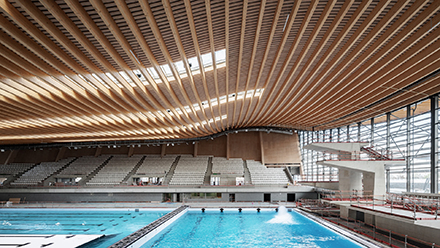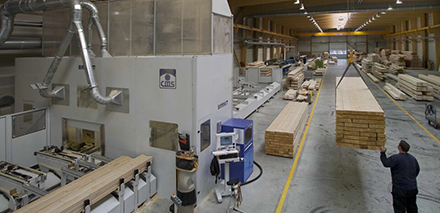There’s something highly unusual about the new Olympic Aquatics Centre on the outskirts of Paris. It’s not just the building’s striking form, with its massive, Pringle-shaped solar roof. It’s not solely that the 5,000-seat venue, constructed mainly from wood, was pieced together like a Lego set. Source: Bloomberg
It’s also the fact that the centre, designed by architecture firms Ateliers 2/3/4/ and VenhoevenCS, will be the main architectural icon for a Summer Games that is actively trying not to build them.
Every host city of the Summer Olympics tries to use them to power some major transformative project. It might be a huge expansion of a metro system (as in Athens in 2004), the redevelopment of a large tract of derelict land (which London undertook in 2012) or the re-planning of an underused seafront (like the one Barcelona carried out in 1992).
But Paris 2024 wants to make sustainability, rather than monumental construction, its chief legacy. Compared to the pharaonic projects of the past, the aspiration might seem almost perverse.
There are still some new projects: The Olympic Village, north of Paris, will be an eco-quarter where all buildings under eight floors will be made from wood and glass, and all energy will be sustainably sourced via heat pumps and renewables. An 8,000-capacity arena at Porte de la Chapelle, comprised of a recycled aluminum façade around a wooden structure, is destined to live on as the home for Paris’ basketball team, as well as two public gyms.
But overall, 95% of the Olympics venues will be facilities that either already existed or that will be dismantled for reuse after the Games.
This make-do-and-mend approach could, organizers hope, help provide a springboard for a green transformation of France’s construction industry. France hopes to cut carbon in the building sector as the European Union strives to reduce the bloc’s overall emissions by 55% by 2030. That will primarily mean retrofitting existing structures but using more wood in new construction — including the advanced wood components known as mass timber is expected to play a significant role as well. (A French government proposal in 2020 to require all new public buildings to use 50% wood or other biomaterials was, however, ultimately dropped.)
Industry experts are optimistic about France’s willingness to manage this swing, even if it lags behind some neighbours in areas such as renewable energy. “While our wood construction industry is not as developed as, say, Austria or Germany,” says Luc Floissac, an environmental adviser and researcher at Toulouse University, “our use of bio-based materials such as straw for buildings is already ahead of all the other European countries combined.” Investment has also backed up official enthusiasm, Floissac says. The government has so far issued around €200 million ($218 million) in subsidies to projects using wood and other biomaterials.
This push has already powered some growth. The wood construction market reached €4.6 billion last year, an increase of 14% since 2020, according to a July report from timber and forestry industry group France Bois Forêt. The proportion of new buildings constructed in wood has still not risen dramatically, however. They comprised 18.3% of new non-residential buildings in 2022, up only slightly over 16.8% in 2020. Wood-built residential structures remained at around 6% over the same period. The sector is nonetheless targeting a total construction-market share of 20% to 30% by 2030, wresting some of that away from the currently dominant material, concrete. And it’s ramping up its industrial capacities in order to meet that goal.
“Industrial equipment in France is undersized,” says Dominique Cottineau, director of the Wood Construction Industry Union (UICB). “But the trajectory is changing, and we’re going to be building with a lot more wood than before.”
The new Aquatics Center wasn’t primarily built near Paris but hundreds of miles away, in a bucolic, half-timbered village near the German border. The structure was prefabricated at a distance by wood construction company Mathis, which has been sawing and whittling timber for buildings on the same site in Alsace since 1809. Each piece of the final building was planned, cut, glued, and bent into shape in Mathis’ yard before being shipped to Paris for assembly on site.
The potential advantages of building in wood are legion. For many architects, its beauty without extra finishing provides both practical and aesthetic benefits. “We wanted to use the least amount of material possible, and wood means we don’t have to use drywall or other fixes used in construction to hide structural elements,” says Laure Mériaud, partner at Ateliers 2/3/4/.
That can in turn give wooden buildings an extra sensual charm, according to Cécilia Gross, partner at VenhoevenCS.
“We don’t have to paint it,” she says. “It has warmth, it has colour and it has a scent. You can smell it when you’re in the pool.”
Harvested wood is generally considered carbon neutral if all trees felled are replaced with new saplings that are allowed to grow to the same age. Despite being able to withstand considerable pressure and wear, wood is relatively light, further reducing emissions by lessening the load on construction machinery. Mass timber isn’t even particularly flammable when used carefully. It is actually harder to ignite and conducts heat less rapidly than a steel frame, testing has showed.
Visiting Mathis in Alsace, other clear advantages to wood construction become evident. The structures the company builds can be vast and complex in design, with computers programmed to dictate the shape and volume of components to be cut, and with precise scheduling of work so that the right pieces are ready for shipment in the correct order for construction. But from there, things get easier. The hangars of Mathis’ woodyard are committed to relatively straightforward processes, with spaces for drying wood, cutting planks into pieces and gluing them together. The only grand-scale machinery is a press that bends huge pieces of laminated wood — of up to 45 meters (148 feet) in length into arch shapes for roof supports. Even here the material is pliable enough that the wood can gain and retain the desired shape after just a day in the press, before being shipped to a construction site.
So streamlined and effective is the process, says Frank Mathis, the company’s president, that during its work on the office building being used as the Paris 2024 headquarters, the woodyard prepared enough components to build a tennis court-sized part of the structure every day.
The process of assembling the buildings onsite is even swifter. “With some of our products,” Mathis says, “we assemble the pieces twice as fast as we fabricate them.” He says there are hangars in and around Paris waiting to be filled with wood components ready for assembly.
Despite the proficiency of companies like Mathis, there are still kinks to be ironed out further up the wood supply chain. One key issue is the provenance and production location of the timber used. If construction timber must travel far, its emissions rise and overall sustainability falls sharply.
That’s why France has set itself the ambitious target of sourcing 50% of its construction timber from domestic forests a goal the Aquatics Centre has neared with between 30% and 40% of its wood, mainly Douglas fir and spruce, sourced from within France.
Compared to global centres for wood construction like Canada and Norway, France doesn’t have a reputation for being an inexhaustibly endless sea of trees. That could make its 50% target particularly challenging. France’s potential as a timber producer is nonetheless substantial, says Georges-Henri Florentin, president of France Bois 24, an organization formed to encourage wood construction during and after the Olympics. He says France is currently harvesting just 60% of the wood it is able to fell sustainably.
Its forests are nonetheless hard to manage and utilize. While the country is covered in 17 million hectares (66,000 square miles) of wood, three-quarters of that is on private land, broken up into small parcels.
“There’s a myriad of very small owners, and it’s hard to figure out who owns what. Some people don’t even realize that they have forests,” says Jérôme Martinez, head of the Bois de France certification label, which guarantees that wood is both sourced and processed in the country. “It’s a real stumbling block.”
French wood is like all commercial timber also vulnerable to geopolitical shocks that make its price unstable. According to Frank Mathis, the war in Ukraine forced him to “hunt down wood truckload by truckload to keep the woodyard running” as supplies from the former Soviet Union dwindled and other European producers diverted their timber across the Atlantic for higher prices.
The advantages of building in wood can still outweigh these hurdles, as another venue for the upcoming Olympics reveals. Located close to the base of the Eiffel Tower, the Grand Palais Éphémère opened in 2021 as a temporary gallery space during the renovation of Paris’ main exhibition hall, the belle époque Grand Palais.
Now due to host Olympic judo, wrestling, wheelchair rugby and para judo, the 10,000-square-meter (107,000-square-foot) hall is defined by 44 wooden arches that preclude the need for columns breaking up the space. After the Games, the hall will be broken down into smaller units that can then be sold off for reuse elsewhere. Not only is the venue, designed by Jean-Michel Wilmotte, sustainable the wood’s insulating properties reduce energy use its ephemeral nature makes it perfect for a country with a historic architectural fabric into which new buildings can only be inserted with care. Modern wood buildings may not entirely match with France’s history, but their elegance and delicacy certainly do.









